China and Covid19
CCTV New Year’s Gala 2020: Highlights and Must-Knows (Liveblog)
What is Chinese New Year without the CCTV Spring Gala? What’s on Weibo reports the must-knows of the 2020 ‘Chunwan.’
Published
5 years agoon

WHAT’S ON WEIBO ARCHIVE | PREMIUM CONTENT ARTICLE
Chinese social media is dominated by two topics today: the CCTV New Year Gala (Chunwan) and the outbreak of the coronavirus. Watch the livestream of the CCTV Gala here, and we will keep you updated with tonight’s highlights and must-knows as we will add more information to this post throughout the night. (This liveblog is now closed.)
As the Year of the Rat is just around the corner, millions of people in China and beyond are starting the countdown to the Chinese New Year by watching the CCTV Spring Festival Gala, commonly abbreviated in Chinese as Chunwan (春晚).
The role of social media in watching the event has become increasingly important throughout the years, with topics relating to the Chunwan becoming trending days before.
Making fun of the show and criticizing it is part of the viewer’s experience, although the hashtag used for these kinds of online discussions (such as “Spring Festival Gala Roast” #春晚吐槽#) are sometimes blocked.
The Gala starts at 20.00 China Central Time on January 24. Follow live on Youtube here, or see CCTV livestreaming here.
About the CCTV New Year’s Gala
Since its very first airing in 1983, the Spring Festival Gala has captured an audience of millions. In 2010, the live Gala had a viewership of 730 million; in 2014, it had reached a viewership of 900 million, and in 2019, over a billion people watched the Gala on TV and online, making the show much bigger in terms of viewership than, for example, the Super Bowl.
The show lasts a total of four hours, and has around 30 different acts, from dance to singing and acrobatics. The acts that are both most-loved and most-dreaded are the comic sketches (小品) and crosstalk (相声); they are usually the funniest, but also convey the most political messages.
As viewer ratings of the CCTV Gala in the 21st century have skyrocketed, so has the critique on the show – which seems to be growing year-on-year.
According to many viewers, the spectacle generally is often “way too political” with its display of communist nostalgia, including the performance of different revolutionary songs such as “Without the Communist Party, There is No New China” (没有共产党就没有新中国).
To take a look at what was going on during the Spring Gala’s previous shows, also see how What’s on Weibo covered this event in 2016, in 2017, in 2018, and in 2019.
Live updates
Check for some live updates below. (We might be quiet every now and then, but if you leave this page open you’ll hear a ping when we add a new post). (Update: Live blog closed)
Happy New Year Wishes from Wuhan People’s Hospital
[Jan 24 / 17:30 CST]
Medical staff at the dedicated isolation ward of Wuhan’s People’s Hospital wish everyone a Happy New Year, saying: “We’re here, don’t worry [and celebrate Spring Festival]” – a hashtag that’s now propagated online to ease the #coronavirus panic. #有我们在大家安心过年
Medical staff at the dedicated isolation ward of Wuhan’s People’s Hospital wish everyone a Happy New Year, saying: “We’re here, don’t worry [and celebrate Spring Festival]” – a hashtag that’s now propagated online to ease the #coronavirus panic. #有我们在大家安心过年 pic.twitter.com/byWLd8DJ1i
— Manya Koetse (@manyapan) January 24, 2020
Director of the Gala: Yang Dongsheng
[Jan 24 / 17:57 CST]
This year’s director is Yang Dongsheng (杨东升) from Guangdong (see picture below), who also directed the Gala in 2017 and 2018. With Avatar-like settings for dance and singing acts in 2017, spectacular light and dance show in 2018, we can also expect tonight’s show to be colorful and big.

Jiayou Wuhan, Jiayou China!
[Jan 24 / 19:57 CST]
In the ten minutes leading up to the CCTV Gala, it is clear that the coronavirus outbreak in Wuhan is not a news topic that will be ignored tonight.
The presenters have a strong message showing their support to the patients and people in Wuhan and beyond, saying: “Jiayou Wuhan, Jiayou China!” – Come on Wuhan! Come on China!

It just started and the first memes are here
[Jan 24 / 20:10 CST]

The first act has only just completed and already there are memes going around Chinese social media, comparing the dancers in the act to Chinese cabbages..
Time to have a “live look” inside the main hospital in Wuhan!
[Jan 24 / 20:40 CST]

A special moment during the CCTV Gala as the show switched to one of Wuhan’s main hospitals right now to get an update from the nurses there who are spending their Chinese New Year night taking care of the many people infected with the coronavirus.
According to the presenter, the switch was “very last minute.”
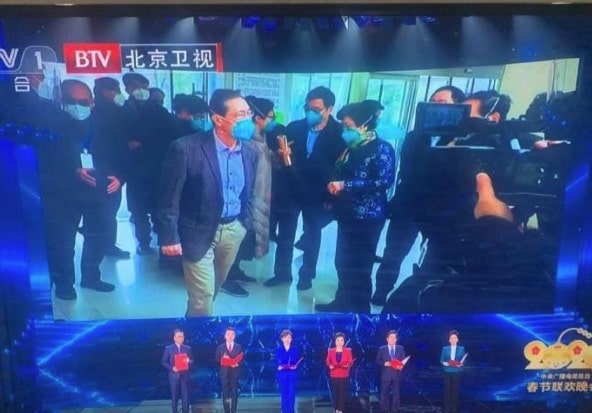
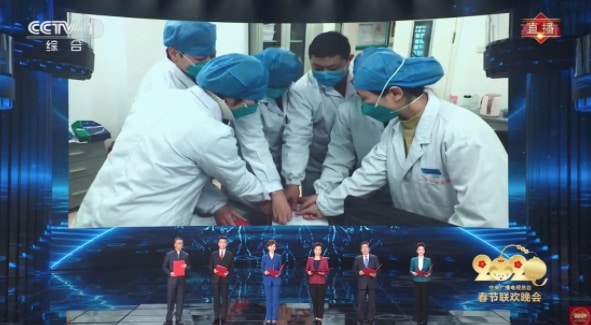
The presenters also take this time to thank all of those people sacrificing their time and energy to take care of the ill.
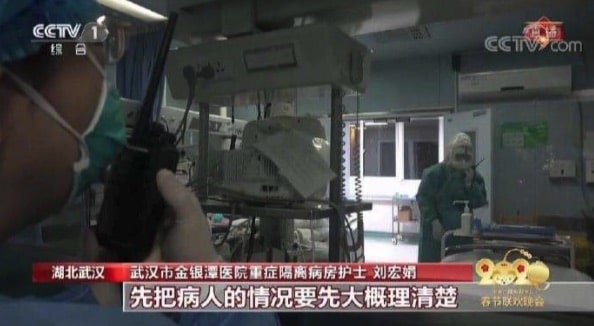
Global Times editor Hu Xijin also posted about the “last minute” Wuhan segment, and praised it for communicating the feelings and worries of Chinese people.

“Who has been eating wild game?!”
[Jan 24 / 20:44 CST]
With the outbreak of the coronavirus, the eating of wild game has been severely criticized on Weibo these days. This meme of the sketch performed by actor Yue Yunpeng (岳云鹏) during tonight’s Gala says: “Let’s see which idiot still dares to eat wild game?!”
Read more about the backlash against wild game eating here.

Some people only think about food during Chinese New Year…
[Jan 24 / 20:53 CST]
We already said that this CCTV Gala, directed by Yang Dongsheng, would be a colorful one. For some viewers, the dance performance set up at the start of this night just looks like food.
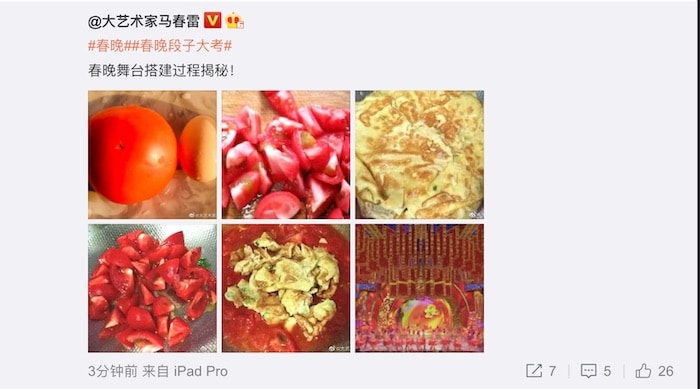
[Jan 24 / 21:03 CST]

#春晚历史上首次没有彩排的片段#
[Jan 24 / 21:18 CST]
As the night continues, people on Weibo are still talking about the segment in the show that cut to the Wuhan hospital. For the first time since 1983, the CCTV Gala included a segment that was not rehearsed. The topic is making its way around social media under the hashtag “For the first time in history, the CCTV Gala airs unrehearsed segment” (#春晚历史上首次没有彩排的片段#).
How much is live?
[Jan 24 / 21:45 CST]
Although this Gala is a live broadcast from CCTV’s No.1 Studio in Beijing, combined with broadcasting from different other venues (this year: Guangdong, HK, Zhengzhou, Macao). every year’s show has a taped version of the full dress rehearsal. The tape runs together with the live broadcast, so that in the event of a problem or disruption, the producers can seamlessly switch to the taped version without TV audiences noticing anything.
Because of the outbreak of the coronavirus, Beijing seems to be the only location that is actually aired live tonight, with the other locations using pre-recorded versions.
What’s tonight’s theme?
[Jan 24 / 21:53 CST]
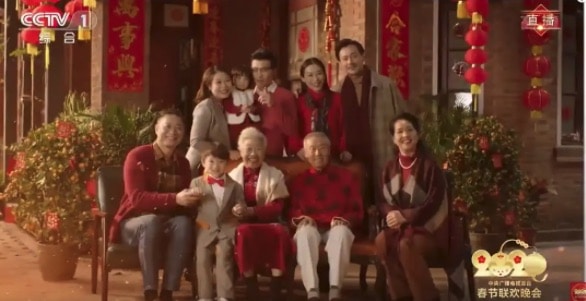
Every year, the CCTV Gala has a different theme. Sometimes, these themes are very clear, such as the “Chinese Dream” in 2016, or “National Unity” in 2017.
This year marked the 70th anniversary of the People’s Republic of China, and the Gala seems to have an umbrella theme capturing issues such as the celebration of 70 years ‘New China,’ the fight against poverty, unity among all languages and ethnic groups within China, and China’s important role in international society (especially marked by the first act, showing dancing and performances from different One Belt, One Road countries).
2020, I Love You
[Jan 24 / 21:53 CST]
This catchy poppy song is called “Hello 2020″(你好2020), performed by various artists.
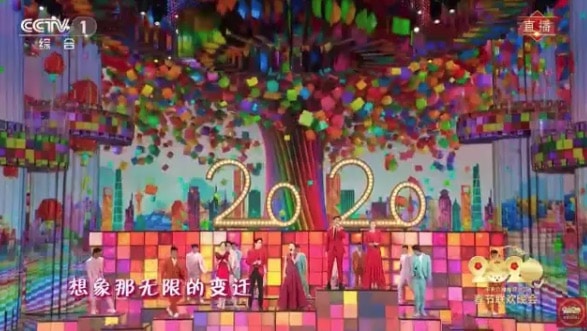
Stunning Dance “Morning Light”
[Jan 24 / 22:02 CST]
This is one of the dance performances of tonight, called “Morning Light” and led by Zhu Jiejing. The performance is by the Shanghai Song and Dance Troupe. Zhu Jiejing was born in October, 1985 in Jiaxing of Zhejiang Province. She won a top award for dance in China.


Kuaishou x CCTV Gala
[Jan 24 / 22:06 CST]
Tonight’s show is done in cooperation with Kuaishou, a hugely popular Chinese video sharing app. The CCTV Gala usually has different social media and/or online partners – which usually means a boost for these online platforms.
“My Motherland”
[Jan 24 / 22:32 CST]
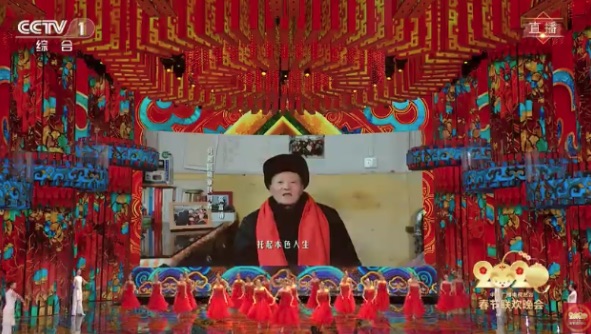
The inevitable patriotic song “My Motherland” is here, including a segment with the 90-year-old singer Guo Lanying (郭兰英).

BUT WHERE ARE THE DANCING ROBOTS?!
This is Guo Lanying singing the song for the first time at the Chunwan in her younger years, 30 years ago:


Spectacular footage from Zhengzhou
[Jan 24 / 23:03 CST]
We’re moving to one of the venues outside of Beijing – this is one of the prerecorded segments including piano play by the renowned Lang Lang, followed up with a song by Sun Nan (孙楠) and Li Yuchun (李宇春).
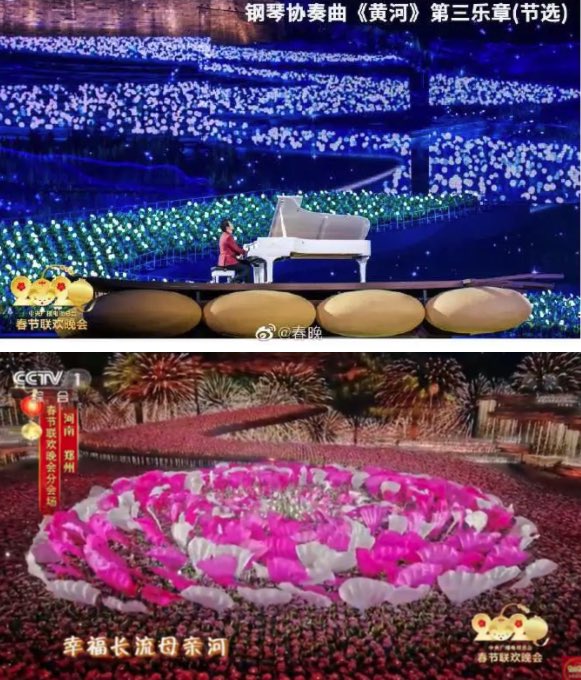
Meanwhile on Weibo
[Jan 24 / 23:04 CST]
Seen on Weibo: running out of proper face protection masks, these medical workers are using file folders to make their own face masks. #coronarovirus pic.twitter.com/gHtbAkHeu7
— Manya Koetse (@manyapan) January 24, 2020
Mixed feelings: CoronaVirus and Chunwan share the Weibo stage
[Jan 24 / 23:18 CST]
On Weibo, there are many netizens sharing their mixed feelings about tonight and going on social media, with some posts being about the CCTV Gala and happiness, and the others being about the situation in Wuhan and the despair. “I am laughing and crying,” some write.

[Jan 24 / 23:39 CST]
On Weibo, @HuXijin_GT posted some of the photos that are now being shared of the army coming in to offer (medical) help amidst #coronavirus outbreak. Many people on Weibo address their mixed feelings: happiness over #Chinesenewyear, worry and fear over the Wuhan situation. pic.twitter.com/6YVmA3GHkL
— Manya Koetse (@manyapan) January 24, 2020
A ‘Yellow River’ of humans
[Jan 24 / 23:47 CST]

Chunwan and Coronavirus: stark contrast night
[Jan 24 / 23:52 CST]
While Miranda and Manya are watching the CCTV Gala and keeping an eye on social media developments, editor-in-chief Manya just joined BBC World News to briefly address the current social media developments regarding the coronavirus outbreak. See embedded tweet below.
In between watching the #CCTVGala and staying glued to Weibo, I just joined BBC World News live to comment on the social media environment in China during the #coronavirus outbreak. Segment of interview 👇 pic.twitter.com/dzwzI8zYnm
— Manya Koetse (@manyapan) January 24, 2020
Will tonight’s show break viewership records (again)?
[Jan 25 / 00:24 CST]
Over the past few years, the number of people watching the CCTV Gala has increased because of the many people watching the event via online platforms. Youtube is one of the platforms outside of China where the event is being livestreamed, and where over 105,000 people are joining.
Together with the traditional TV audiences, the CCTV online viewership, and the total number of people watching via other apps, will tonight’s show cross the one billion record again?
If you’re not watching the #cctvgala livestream on YouTube: there’s over 105,000 people watching this right now and the chat is going crazy. pic.twitter.com/vGCENUZ7dM
— Manya Koetse (@manyapan) January 24, 2020
Wear your facemask
[Jan 25 / 00:26 CST]
Just before the end of the show, a public service announcement reminds viewers to wear a face mask in times of the Corona virus outbreak.
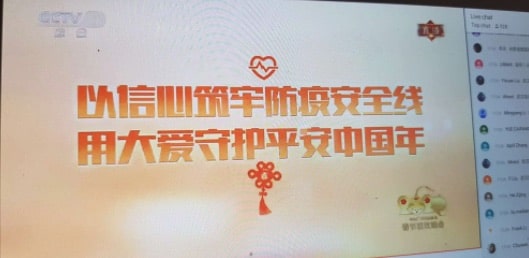
It’s a wrap
[Jan 25 / 00:59 CST]
It’s a wrap for tonight, so we will close our updates here, but stay tuned the coming days and weeks as we will keep a finger on the pulse of everything happening on Chinese social media and online discussions regarding the Chinese New Year travel season and the outbreak of the coronavirus. Thanks for joining, and a Happy New Year of the Rat!
By Manya Koetse and Miranda Barnes
Follow @whatsonweibo
Do you like what we do? You can donate here to keep this site alive & kicking.
Spotted a mistake or want to add something? Please let us know in comments below or email us. First-time commenters, please be patient – we will have to manually approve your comment before it appears.
©2020 Whatsonweibo. All rights reserved. Do not reproduce our content without permission – you can contact us at info@whatsonweibo.com.
Stories that are authored by the What's on Weibo Team are the stories that multiple authors contributed to. Please check the names at the end of the articles to see who the authors are.

Also Read
China and Covid19
Sick Kids, Worried Parents, Overcrowded Hospitals: China’s Peak Flu Season on the Way
“Besides Mycoplasma infections, cases include influenza, Covid-19, Norovirus, and Adenovirus. Heading straight to the hospital could mean entering a cesspool of viruses.”
Published
8 months agoon
November 22, 2023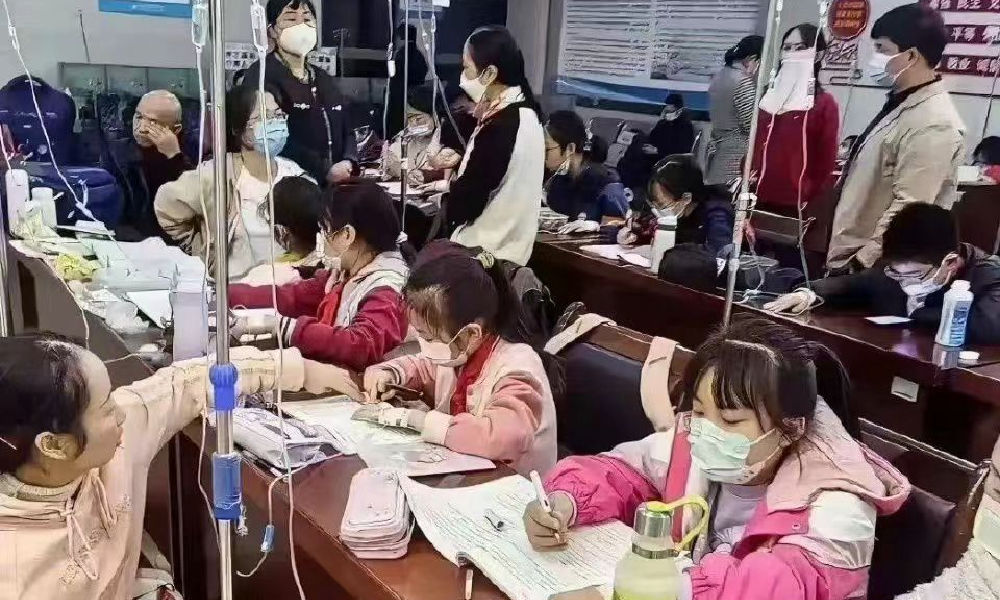
In the early morning of November 21, parents are already queuing up at Xi’an Children’s Hospital with their sons and daughters. It’s not even the line for a doctor’s appointment, but rather for the removal of IV needles.
The scene was captured in a recent video, only one among many videos and images that have been making their rounds on Chinese social media these days (#凌晨的儿童医院拔针也要排队#).
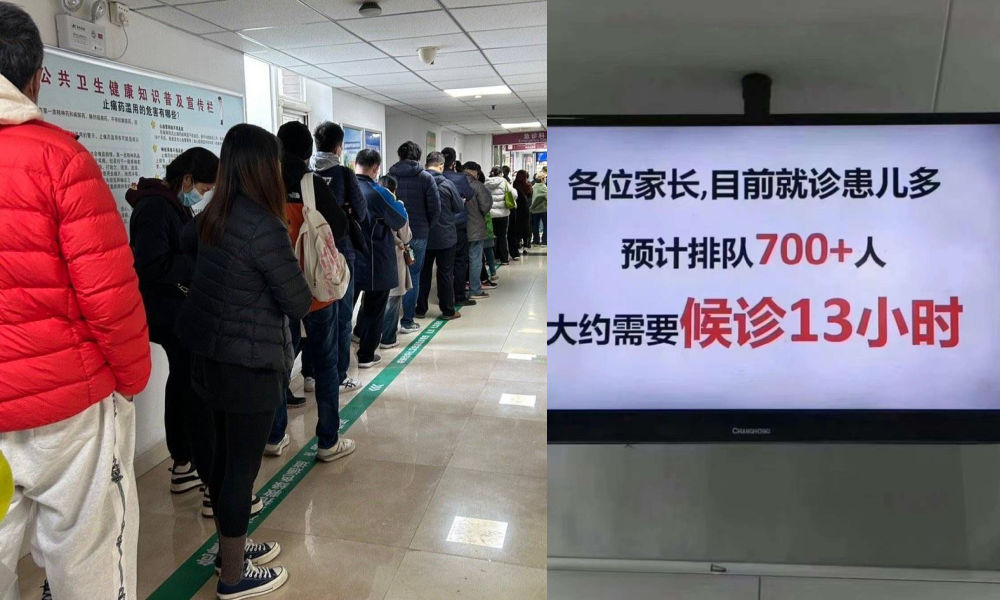
One photo shows a bulletin board at a local hospital warning parents that over 700 patients are waiting in line, estimating a waiting time of more than 13 hours to see a doctor.
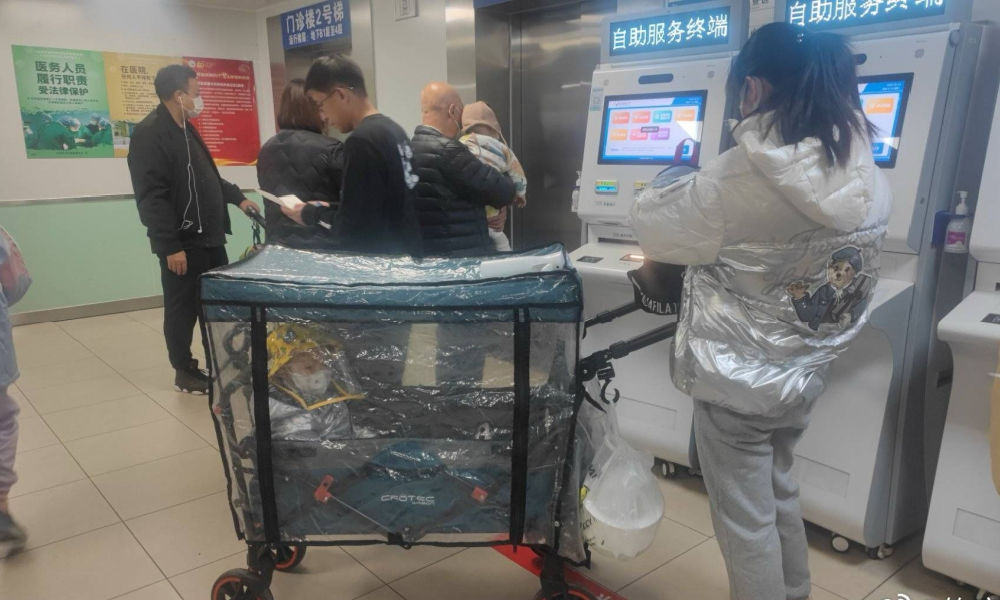
Another image shows children doing their homework while hooked up on an IV.
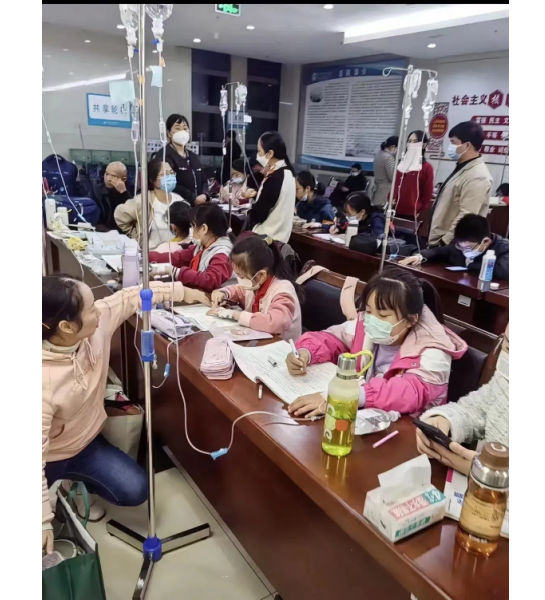
Recent discussions on Chinese social media platforms have highlighted a notable surge in flu cases. The ongoing flu season is particularly impacting children, with multiple viruses concurrently circulating and contributing to a high incidence of respiratory infections.
Among the prevalent respiratory infections affecting children are Mycoplasma pneumoniae infections, influenza, and Adenovirus infection.
The spike in flu cases has resulted in overcrowded children’s hospitals in Beijing and other Chinese cities. Parents sometimes have to wait in line for hours to get an appointment or pick up medication.
According to one reporter at Haibao News (海报新闻), there were so many patients at the Children’s Hospital of Capital Institute of Pediatrics (首都儿科研究所) on November 21st that the outpatient desk stopped accepting new patients by the afternoon. Meanwhile, 628 people were waiting in line to see a doctor at the emergency department.
Reflecting on the past few years, the current flu season marks China’s first ‘normal’ flu peak season since the outbreak of Covid-19 in late 2019 / early 2020 and the end of its stringent zero-Covid policies in December 2022. Compared to many other countries, wearing masks was also commonplace for much longer following the relaxation of Covid policies.
Hu Xijin, the well-known political commentator, noted on Weibo that this year’s flu season seems to be far worse than that of the years before. He also shared that his own granddaughter was suffering from a 40 degrees fever.
“We’re all running a fever in our home. But I didn’t dare to go to the hospital today, although I want my child to go to the hospital tomorrow. I heard waiting times are up to five hours now,” one Weibo user wrote.
“Half of the kids in my child’s class are sick now. The hospital is overflowing with people,” another person commented.
One mother described how her 7-year-old child had been running a fever for eight days already. Seeking medical attention on the first day, the initial diagnosis was a cold. As the fever persisted, daily visits to the hospital ensued, involving multiple hours for IV fluid administration.
While this account stems from a single Weibo post within a fever-advice community, it highlights a broader trend: many parents swiftly resort to hospital visits at the first signs of flu or fever. Several factors contribute to this, including a lack of General Practitioners in China, making hospitals the primary choice for medical consultations also in non-urgent cases.
There is also a strong belief in the efficacy of IV infusion therapy, whether fluid-based or containing medication, as the quickest path to recovery. Multiple factors contribute to the widespread and sometimes irrational use of IV infusions in China. Some clinics are profit-driven and see IV infusions as a way to make more money. Widespread expectations among Chinese patients that IV infusions will make them feel better also play a role, along with some physicians’ lacking knowledge of IV therapy or their uncertainty to distinguish bacterial from viral infections (read more here)
To prevent an overwhelming influx of patients to hospitals, Chinese state media, citing specialists, advise parents to seek medical attention at the hospital only for sick infants under three months old displaying clear signs of fever (with or without cough). For older children, it is recommended to consult a doctor if a high fever persists for 3 to 5 days or if there is a deterioration in respiratory symptoms. Children dealing with fever and (mild) respiratory symptoms can otherwise recover at home.
One Weibo blogger (@奶霸知道) warned parents that taking their child straight to the hospital on the first day of them getting sick could actually be a bad idea. They write:
“(..) pediatric departments are already packed with patients, and it’s not just Mycoplasma infections anymore. Cases include influenza, Covid-19, Norovirus, and Adenovirus. And then, of course, those with bad luck are cross-infected with multiple viruses at the same time, leading to endless cycles. Therefore, if your child experiences mild coughing or a slight fever, consider observing at home first. Heading straight to the hospital could mean entering a cesspool of viruses.”
The hashtag for “fever” saw over 350 million clicks on Weibo within one day on November 22.
Meanwhile, there are also other ongoing discussions on Weibo surrounding the current flu season. One topic revolves around whether children should continue doing their homework while receiving IV fluids in the hospital. Some hospitals have designated special desks and study areas for children.
Although some commenters commend the hospitals for being so considerate, others also remind the parents not to pressure their kids too much and to let them rest when they are not feeling well.
Opinions vary: although some on Chinese social media say it's very thoughtful for hospitals to set up areas where kids can study and read, others blame parents for pressuring their kids to do homework at the hospital instead of resting when not feeling well. pic.twitter.com/gnQD9tFW2c
— Manya Koetse (@manyapan) November 22, 2023
By Manya Koetse, with contributions from Miranda Barnes
Get the story behind the hashtag. Subscribe to What’s on Weibo here to receive our newsletter and get access to our latest articles:
Spotted a mistake or want to add something? Please let us know in comments below or email us. First-time commenters, please be patient – we will have to manually approve your comment before it appears.
©2023 Whatsonweibo. All rights reserved. Do not reproduce our content without permission – you can contact us at info@whatsonweibo.com.
China and Covid19
Repurposing China’s Abandoned Nucleic Acid Booths: 10 Innovative Transformations
Abandoned nucleic acid booths are getting a second life through these new initiatives.
Published
1 year agoon
May 19, 2023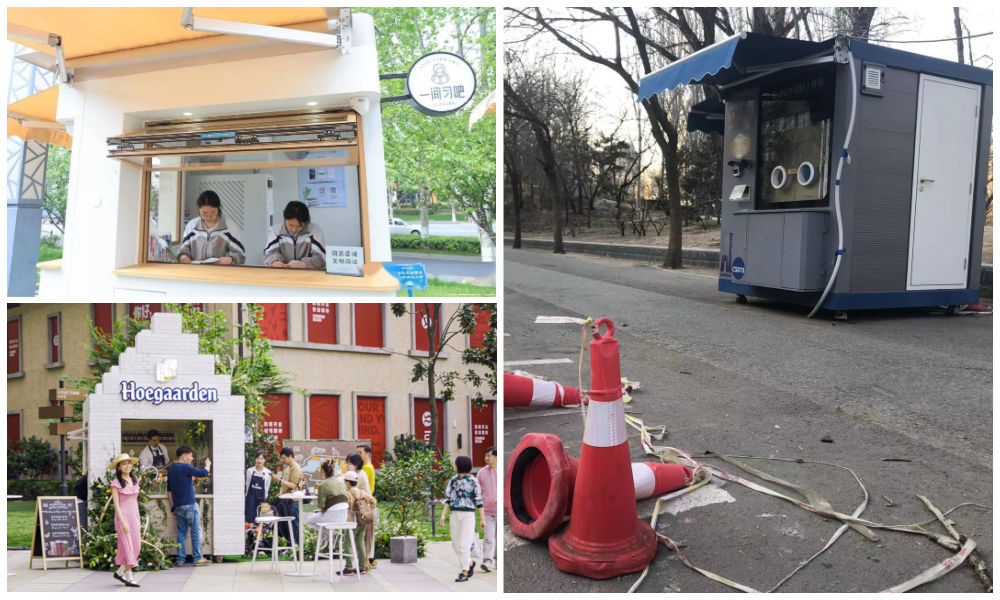
During the pandemic, nucleic acid testing booths in Chinese cities were primarily focused on maintaining physical distance. Now, empty booths are being repurposed to bring people together, serving as new spaces to serve the community and promote social engagement.
Just months ago, nucleic acid testing booths were the most lively spots of some Chinese cities. During the 2022 Shanghai summer, for example, there were massive queues in front of the city’s nucleic acid booths, as people needed a negative PCR test no older than 72 hours for accessing public transport, going to work, or visiting markets and malls.
The word ‘hésuān tíng‘ (核酸亭), nucleic acid booth (also:核酸采样小屋), became a part of China’s pandemic lexicon, just like hésuān dìtú (核酸地图), the nucleic acid test map lauched in May 2022 that would show where you can get a nucleic test.
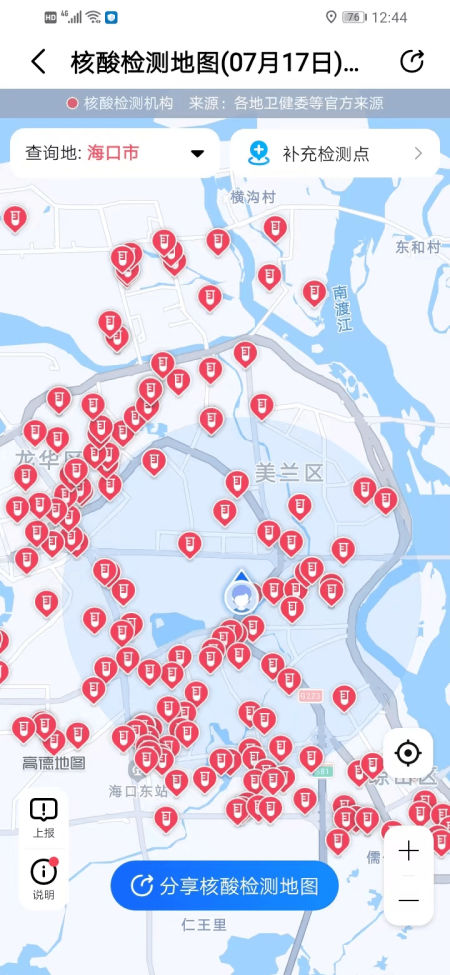
Example of nucleic acid test map.
During Halloween parties in Shanghai in 2022, some people even came dressed up as nucleic test booths – although local authorities could not appreciate the creative costume.
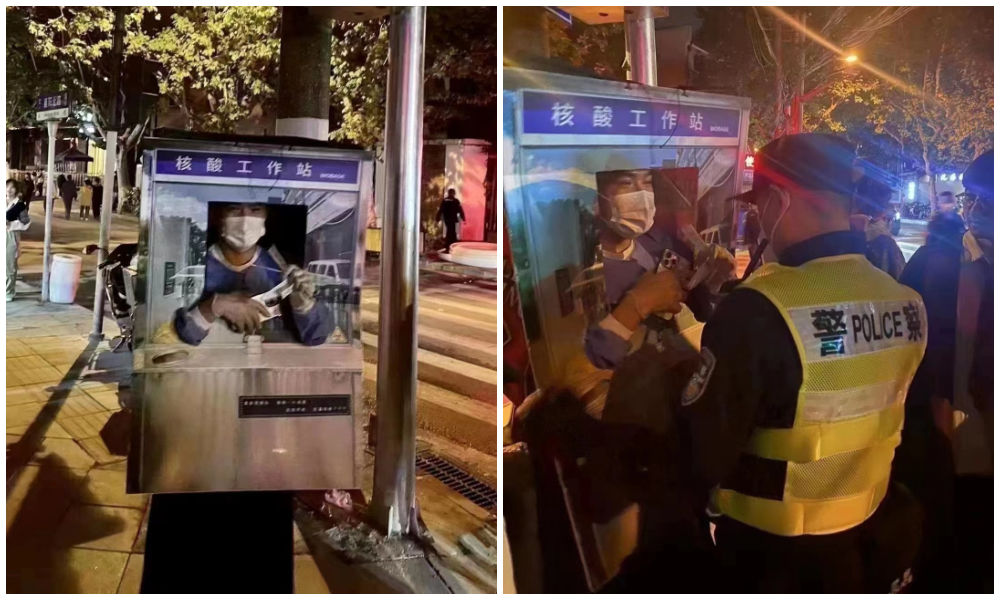
Halloween 2022: dressed up as nucliec acid booths. Via @manyapan twitter.
In December 2022, along with the announced changed rules in China’s ‘zero Covid’ approach, nucleic acid booths were suddenly left dismantled and empty.
With many cities spending millions to set up these booths in central locations, the question soon arose: what should they do with the abandoned booths?
This question also relates to who actually owns them, since the ownership is mixed. Some booths were purchased by authorities, others were bought by companies, and there are also local communities owning their own testing booths. Depending on the contracts and legal implications, not all booths are able to get a new function or be removed yet (Worker’s Daily).
In Tianjin, a total of 266 nucleic acid booths located in Jinghai District were listed for public acquisition earlier this month, and they were acquired for 4.78 million yuan (US$683.300) by a local food and beverage company which will transform the booths into convenience service points, selling snacks or providing other services.
Tianjin is not the only city where old nucleic acid testing booths are being repurposed. While some booths have been discarded, some companies and/or local governments – in cooperation with local communities – have demonstrated creativity by transforming the booths into new landmarks. Since the start of 2023, different cities and districts across China have already begun to repurpose testing booths. Here, we will explore ten different way in which China’s abandoned nucleic test booths get a second chance at a meaningful existence.
1: Pharmacy/Medical Booths
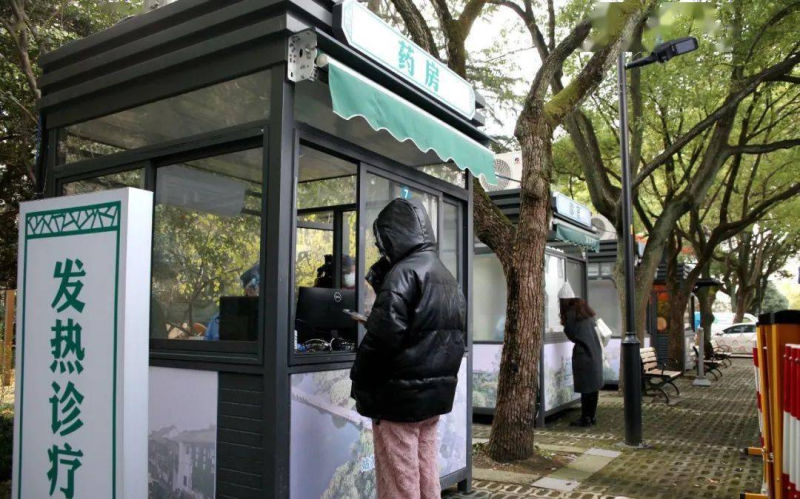
Via ‘copyquan’ republished on Sohu.
Blogger ‘copyquan’ recently explored various ways in which abandoned PCR testing points are being repurposed.
One way in which they are used is as small pharmacies or as medical service points for local residents (居民医疗点). Alleviating the strain on hospitals and pharmacies, this was one of the earliest ways in which the booths were repurposed back in December of 2022 and January of 2023.
Chongqing, Tianjin, and Suzhou were among earlier cities where some testing booths were transformed into convenient medical facilities.
2: Market Stalls
In Suzhou, Jiangsu province, the local government transformed vacant nucleic acid booths into market stalls for the Spring Festival in January 2022, offering them free of charge to businesses to sell local products, snacks, and traditional New Year goods.
The idea was not just meant as a way for small businesses to conveniently sell to local residents, it was also meant as a way to attract more shoppers and promote other businesses in the neighborhood.
3: Community Service Center
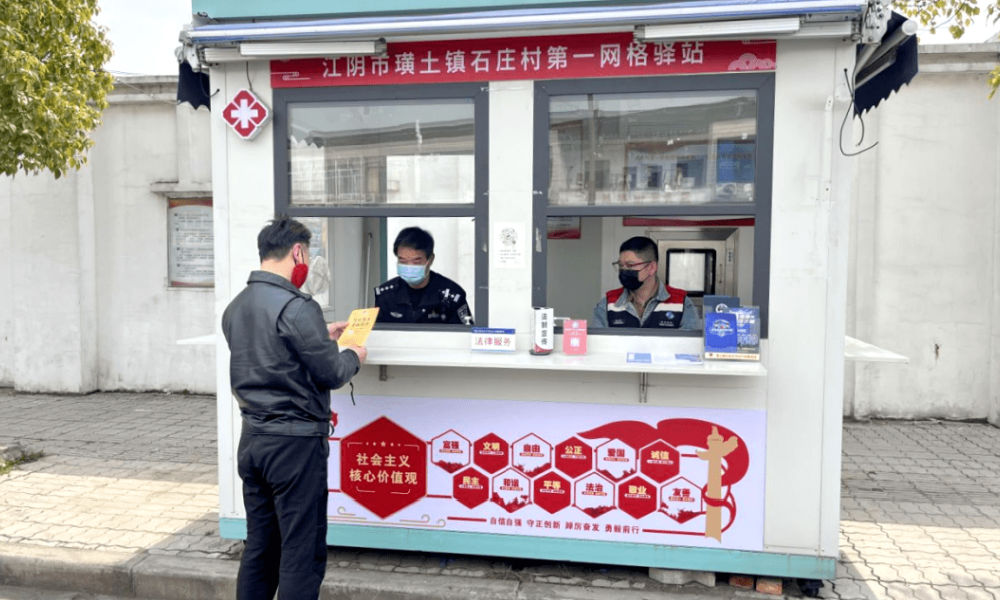
Small grid community center in Shizhuang Village, image via Sohu.
Some residential areas have transformed their local nucleic acid testing booths into community service centers, offering all kinds of convenient services to neighborhood residents.
These little station are called wǎnggé yìzhàn (网格驿站) or “grid service stations,” and they can serve as small community centers where residents can get various kinds of care and support.
4: “Refuel” Stations

In February of this year, 100 idle nucleic acid sampling booths were transformed into so-called “Rider Refuel Stations” (骑士加油站) in Zhejiang’s Pinghu. Although it initially sounds like a place where delivery riders can fill up their fuel tanks, it is actually meant as a place where they themselves can recharge.
Delivery riders and other outdoor workers can come to the ‘refuel’ station to drink some water or tea, warm their hands, warm up some food and take a quick nap.
5: Free Libraries
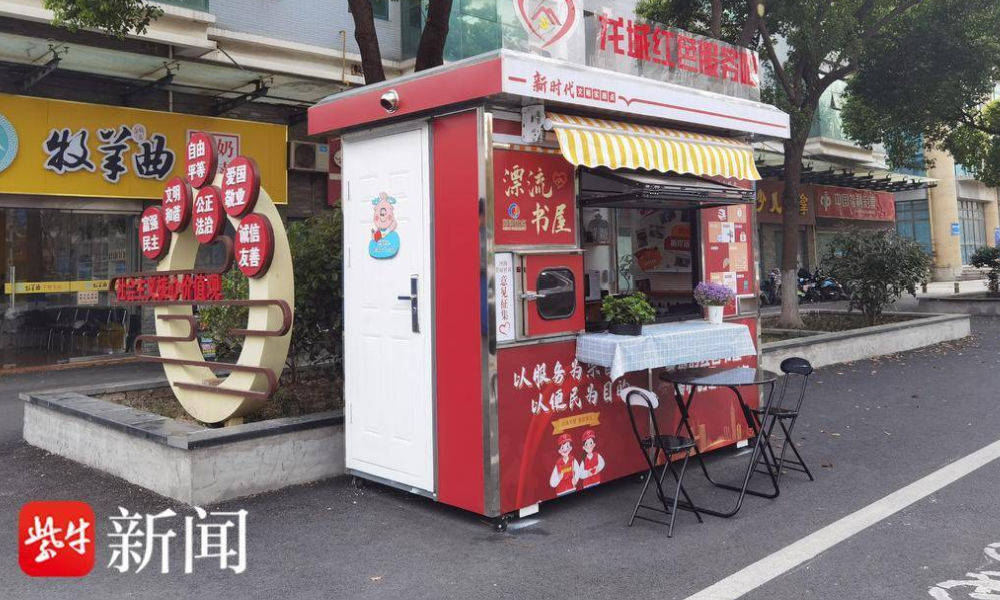
image via sohu.
In various Chinese cities, abandoned nucleic acid booths have been transformed into little free libraries where people can grab some books to read, donate or return other books, and sit down for some reading.
Changzhou is one of the places where you’ll find such “drifting bookstores” (漂流书屋) (see video), but similar initiatives have also been launched in other places, including Suzhou.
6: Study Space
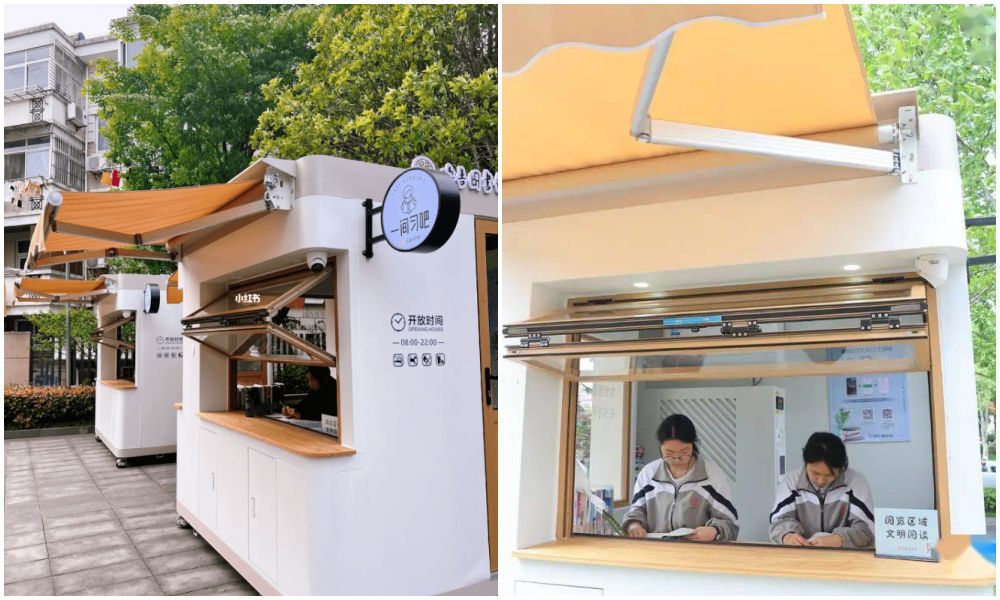
Photos via Copyquan’s article on Sohu.
Another innovative way in which old testing points are being repurposed is by turning them into places where students can sit together to study. The so-called “Let’s Study Space” (一间习吧), fully airconditioned, are opened from 8 in the morning until 22:00 at night.
Students – or any citizens who would like a nice place to study – can make online reservations with their ID cards and scan a QR code to enter the study rooms.
There are currently ten study booths in Anji, and the popular project is an initiative by the Anji County Library in Zhejiang (see video).
7: Beer Kiosk
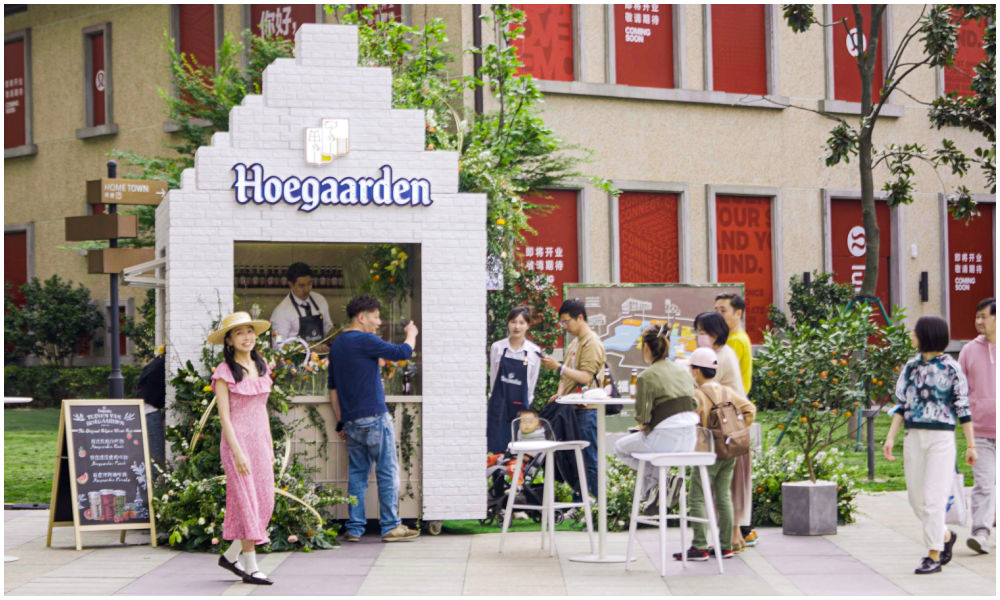
Hoegaarden beer shop, image via Creative Adquan.
Changing an old nucleic acid testing booth into a beer bar is a marketing initiative by the Shanghai McCann ad agency for the Belgium beer brand Hoegaarden.
The idea behind the bar is to celebrate a new spring after the pandemic. The ad agency has revamped a total of six formr nucleic acid booths into small Hoegaarden ‘beer gardens.’
8: Police Box
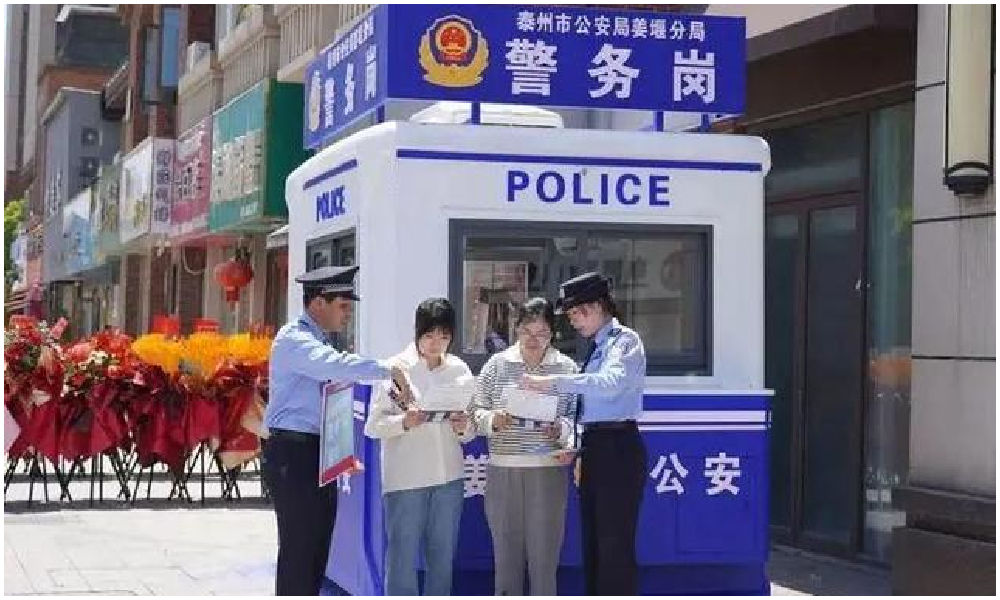
In Taizhou City, Jiangsu Province, authorities have repurposed old testing booths and transformed them into ‘police boxes’ (警务岗亭) to enhance security and improve the visibility of city police among the public.
Currently, a total of eight vacant nucleic acid booths have been renovated into modern police stations, serving as key points for police presence and interaction with the community.
9: Lottery Ticket Booths
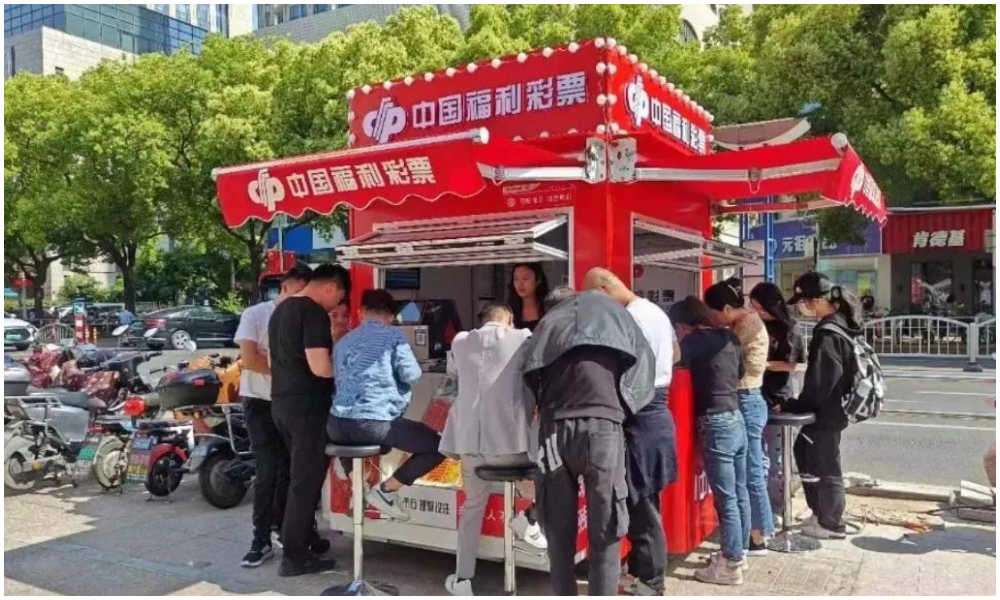
Image via The Paper
Some nucleic acid booths have now been turned into small shops selling lottery tickets for the China Welfare Lottery. One such place turning the kiosks into lottery shops is Songjiang in Shanghai.
Using the booths like this is a win-win situation: they are placed in central locations so it is more convenient for locals to get their lottery tickets, and on the other hand, the sales also help the community, as the profits are used for welfare projects, including care for the elderly.
10: Mini Fire Stations
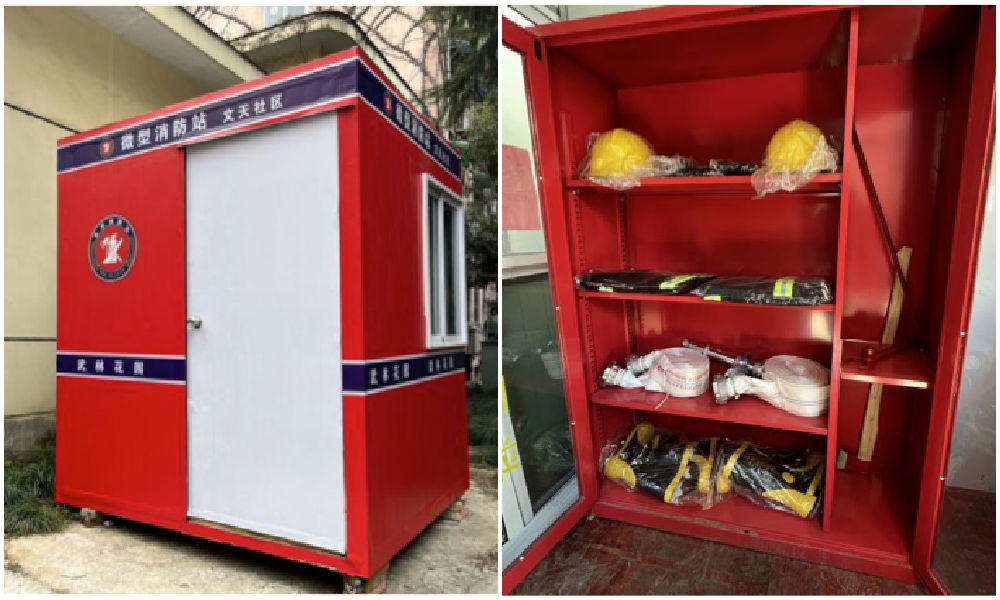
Micro fire stations, images via ZjNews.
Some communities decided that it would be useful to repurpose the testing points and turn them into mini fire kiosks, just allowing enough space for the necessary equipment to quickly respond to fire emergencies.
Want to read more about the end of ‘zero Covid’ in China? Check our other articles here.
By Manya Koetse,
Get the story behind the hashtag. Subscribe to What’s on Weibo here to receive our newsletter and get access to our latest articles:
Spotted a mistake or want to add something? Please let us know in comments below or email us. First-time commenters, please be patient – we will have to manually approve your comment before it appears.
©2023 Whatsonweibo. All rights reserved. Do not reproduce our content without permission – you can contact us at info@whatsonweibo.com.
Subscribe

Weibo Watch: The Future is Here

“Bye Bye Biden”: Biden’s Many Nicknames in Chinese

Enjoying the ‘Sea’ in Beijing’s Ditan Park

A Triumph for “Comrade Trump”: Chinese Social Media Reactions to Trump Rally Shooting

Weibo Watch: Get Up, Stand Up

The Tragic Story of “Fat Cat”: How a Chinese Gamer’s Suicide Went Viral

“Old Bull Eating Young Grass”: 86-Year-Old Chinese Painter Fan Zeng Marries 36-Year-Old Xu Meng

A Brew of Controversy: Lu Xun and LELECHA’s ‘Smoky’ Oolong Tea

Singing Competition or Patriotic Fight? Hunan TV’s ‘Singer 2024’ Stirs Nationalistic Sentiments

Zara Dress Goes Viral in China for Resemblance to Haidilao Apron

Weibo Watch: The Battle for the Bottom Bed

About the “AI Chatbot Based on Xi Jinping” Story

China’s Intensified Social Media Propaganda: “Taiwan Must Return to Motherland”

Weibo Watch: Telling China’s Stories Wrong

Saying Goodbye to “Uncle Wang”: Wang Wenbin Becomes Chinese Ambassador to Cambodia
Get in touch
Would you like to become a contributor, or do you have any tips or suggestions? Get in touch here!
Popular Reads
-

 China Insight3 months ago
China Insight3 months agoThe Tragic Story of “Fat Cat”: How a Chinese Gamer’s Suicide Went Viral
-

 China Music4 months ago
China Music4 months agoThe Chinese Viral TikTok Song Explained (No, It’s Not About Samsung)
-

 China Digital10 months ago
China Digital10 months agoToo Sexy for Weibo? Online Discussions on the Concept of ‘Cābiān’
-
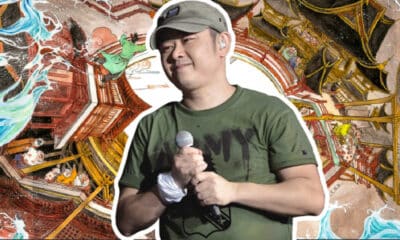
 China Arts & Entertainment12 months ago
China Arts & Entertainment12 months agoBehind 8 Billion Streams: Who is Dao Lang Cursing in the Chinese Hit Song ‘Luocha Kingdom’?





